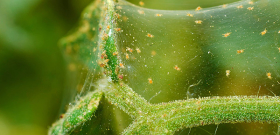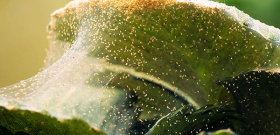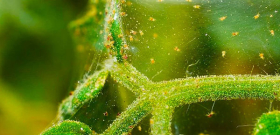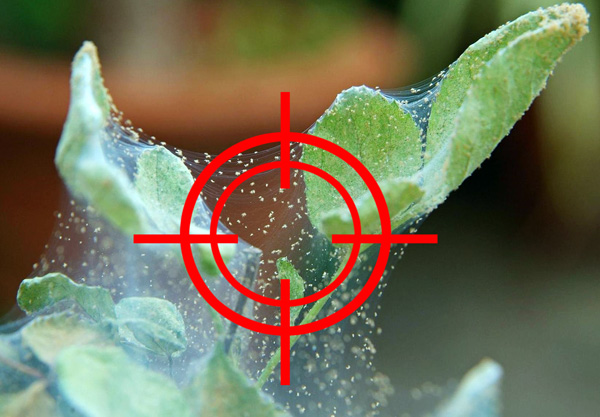
Finding an effective remedy for spider mites is not difficult: more than 100 drugs are on sale today, which, when treated with plants, kill all active stages of tetranychid. Moreover, even with some folk remedies, it is possible to conduct a quite effective fight against these pests. But to choose from them the best remedy for a particular situation is already some problem. At a minimum, because in their diversity you still need to understand and understand what advantages and disadvantages you need to consider when choosing a tool.
The task is complicated by the fact that spider mites develop resistance to many drugs with varying frequency, and sometimes they cannot be destroyed by such means. The fact is that the spider mite is one of the most dangerous pests of agricultural and ornamental crops, with a huge range of forage plants and a high danger to the plants themselves. It was found that if it is not controlled, the infection progresses at a high rate and already in the same year in which the mites first appeared, the affected plant may die, being weakened and unable to endure frosts or a dry summer season.
This means that if mites appear on plants, you need to select a remedy for them as soon as possible, carry out processing and destroy pests.Therefore, let's orient ourselves in the modern range of remedies for tetranychids and the basic rules for choosing among them.
General classification of remedies for spider mites
All remedies for spider mites would most clearly be divided into groups according to the type of active substance, since such active components of each specific class act on pests in a similar way, and preparations based on them are largely interchangeable. The main groups in this case will be:
- Preparations based on organophosphorus compounds (FOS) - karbofos, chlorpyrifos, fenthion, temephos and others. Highly effective, usually odorous, requires alternating with other drugs to avoid development of resistance in ticks;
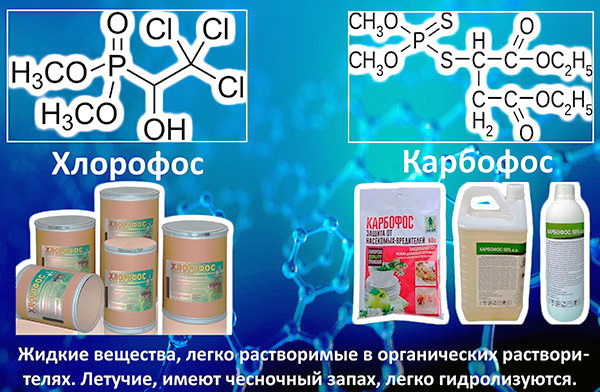
General characteristics of preparations based on organophosphorus compounds.
- Means with pyrethroids - cypermethrin, deltamethrin, permethrin, tetramethrin. Many of them provide the so-called knockdown effect, that is, they kill ticks in a matter of seconds after spraying the plant, but they are often very toxic to humans;
- Avermectin acaricides with active ingredients abamectin, avertin, aversectin C and emamectin benzoate. They differ in the principle of action from pyrethroids and FOSs, due to which they are used to destroy tetranychid populations that are resistant to the means of the above groups;
- Neonicotinoids are substances that are quite safe for humans, the principle of action of which is similar to the principle of action of FOS and pyrethroids, but which, due to their different molecular structure, do not have cross-resistance with them. This group includes imidacloprid, acetamiprid, thiacloprid, thiamethoxam, clothianidin;
- Preparations with substances of hormonal action - clofentezin, buprofezin and flufenzin. They have a radically different effect on ticks, do not kill them, but sterilize and block their development, which leads to the rapid extinction of the population;
- Products based on phenyl-substituted tetronic acids. Their main advantage is the ability to penetrate through the shell into the eggs of ticks and destroy the embryos, which makes it possible to destroy pests in one correct treatment;
- Carbamate acaricides based on propoxur, carbosulfan, carbofuran, methomyl and bendiocarb. They are notable for their systemic action after penetration into plant tissues - mites die when they suck plant juices with a drug that has penetrated there, up to 10 weeks after treatment, due to which carbamates are often used to protect seedlings of flowers and fruit plants. At the same time, due to toxicity to humans and pets, the use of these agents is somewhat limited;
- Means based on other substances - pyridaben, bromopropylate, propargite. The properties of each such component are specific, and therefore preparations based on them have specific features;
- Complex agents, which include acaricides from two or more different groups. As a rule, they are used when ticks have high resistance to any type of active substances;
- Folk remedies, which include drugs manufactured independently and used in private practice. These are vinegar, soap, ammonia, a decoction of garlic and onion peel, and many other products that cannot be combined according to the active substance, but which, nevertheless, stand out quite clearly from the list of other products.
Preparations of different groups from the above list are approximately comparable in price and effectiveness with each other, and in specialized stores or on the market you can buy almost any of them (let the reader not be scared by the difficult-to-pronounce names of the active ingredients - this complexity does not correlate with the simplicity of the name of the remedy itself and its value).
On a note
Separately, it is worth noting predatory mites, the use of which is considered the most effective way to combat tetranychids. This is a method of biological protection of plants - certain types of predatory mites are natural enemies of spider mites and, if possible, feed only on them. Such ticks are purchased in large quantities from special farms and released in the garden, field or greenhouse. Voracious predators eat both spider mites, and their eggs, and other small pests, and before the onset of cold weather they ensure the almost complete absence of tetranychids in the territory in which they were released. If the purchase of such ticks is economically feasible, they are easier and more effective to use than various chemical acaricides.
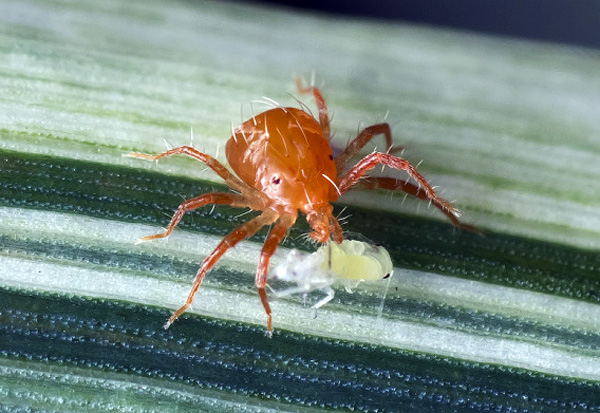
The predatory mite phytoseiulus destroys many pests on plants, including the spider mite.
From the entire list above, it makes no sense to look for the unambiguously best remedy. All of them are good in one situation or another, almost all of them allow you to destroy spider mites, but each of them has certain advantages and disadvantages that you need to know and take into account in order for the treatment of plants with them to give the maximum effect. Let's take a closer look at the most popular of these tools.
Preparations based on organophosphorus compounds
FOSs are popular mainly due to a very wide range of their activity. They are known primarily as effective insecticides, and due to their approximately similar action on both insects and mites, they are used for acaricidal treatment.
The principle of action of organophosphorus compounds is the phosphorylation of acetylcholinesterase, which leads to its inactivation, the accumulation of acetylcholine in the nerve synapses in ticks, the development of strong excitation, which turns into paralysis and death. In the body of warm-blooded animals, this process proceeds much more slowly, and therefore only very large doses of a particular drug result in poisoning.
The most famous and frequently used representatives of this class of drugs are karbofos (drugs Malathion, Antiklesh, Karbofos, Fufanon, Fufanon Nova), chlorpyrifos (Dursban, Parus, Cyclone), diazinon (Barguzin, Grizzly, Medvetoks), dimethoate (Binom, Kinfos, Fostran , Etisso), pyrimiphosmethyl (Actellik). But chlorophos and dichlorvos, also belonging to this group, are ineffective against spider mites.
Dimethoate is the most promising as an acaricide - it penetrates into plant tissues, sometimes even at the seed treatment stage, stays here for a long time and poisons ticks that begin to suck juice.
Plants must be treated with all organophosphorus compounds before flowering and after harvesting in order to avoid getting acaricides into fruits and fruit parts, which is fraught with poisoning of people.
Antiklesh
Antiklesch - a concentrated solution of karbofos in water at a concentration of 525 g / l. To destroy spider mites, it must be diluted in water in a ratio of 10 ml of the drug per 10 liters of water and sprayed entirely on the bushes.In accordance with the instructions, raspberries are sprayed before flowering and after harvesting, apple trees, cucumbers and tomatoes (including indoors) - at any time during the growing season.

Anti-mite is one of the most effective and proven means to combat spider mites.
Given the possibility of developing resistance to the drug within one year, treatment with Antiklesh should be alternated with the use of other drugs. Given the low price (about 25 rubles per 10 ml bottle), this remedy can be considered one of the most preferable for treating plants in the open field from spider mites. It is better for them not to spray home flowers because of the strong unpleasant smell of the product.
On a note
Do not confuse Antiklesh and Antiklesh-Pro. The second is a drug based on pyridabene.
Pyrethroids to kill spider mites
The principle of action of pyrethroids is in many respects similar to that of FOS - they provide a long-term opening of sodium channels in nerve cells and the release of a large amount of acetylcholine, more than can be associated with the amount of acetylcholinesterase present in the tissues. The result is similar to the effect when using organophosphorus acaricides - the tick develops complete paralysis and dies.
Preparations based on pyrethroids are the most widely represented on the market. Among them are such well-known remedies as Intavir, Proteus, Accord, Caesar, Tsunami, Spark, Ram and others, especially often used against spider mites. They could be considered optimal preparations for combating this pest, if not for the high rate of development of resistance to them in ticks.It is for this reason that they are usually alternated with organophosphorus compounds in the gardening schedule.
Inta-vir
By and large, Inta-vir is a synonym for the name of the active substance cypermethrin, but the drug of the same name is also produced under the same name. This tool is a water-soluble tablet weighing 8 g per package, intended for use in personal household plots. One such tablet is dissolved in 10 liters of water and the plants are sprayed with the resulting working solution in accordance with the instructions for use:
- Cucumbers, tomatoes, potatoes, apple, pear, quince, conifers, marigolds, roses - processing during the growing season in an amount specific to each particular crop;
- Currants, gooseberries, raspberries, strawberries, cherries, sweet cherries - before flowering and after harvesting.
One tablet will be enough to process up to 50 square meters of potato planting, from 2 to 5 liters of working solution will be required to process one tree, depending on the size of the plant. Shrubs are sprayed at the rate of 2 liters of working solution per 10 bushes.
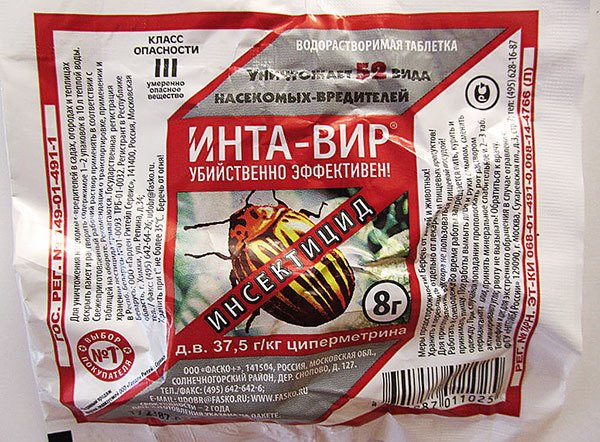
Inta-vir is available in the form of a tablet and destroys not only spider mites, but also other types of pests.
Simply put, Inta-vir is a good alternative to Fufanon or Antiklesch. If they were processed in the spring, before flowering, then after harvesting the plants can be treated with Inta-vir to be sure that the main part of the spider mites (including the females leaving for the winter) died.
Means against spider mites based on avermectins
All avermectins stimulate the release of gamma-aminobutyric acid into the nervous tissue of the tick, which leads to rapidly increasing excitation and paralysis. At the same time, even if the mite population is resistant to OPs or pyrethroids, products with avermectin acaricides will effectively destroy these pests.
The most popular products from this group are Fitoverm, Aktofit, Vertimek. With their help, you can fight spider mites even at home, since they are of little danger to humans. However, for maximum safety, even when using them, it is better to spray plants in a respirator or at least in a mask.
Another interesting feature of avermectin acaricidal preparations is that they act only on the feeding stages of mites. This means that they can only be applied in the spring and during the summer. In autumn, when red females appear on the trees, ready to leave for the winter, the drug will not kill them and they will safely leave for the winter.
Fitoverm
Fitoverm is the most famous and affordable avermectin acaricide. It contains aversectin C as an active ingredient, it can be used at any stage of fruit ripening, due to which it is used as a summer alternative to FOS and pyrethroids. It is quite expensive - about 9,000 rubles per liter of concentrated emulsion, but very economical to use: the instructions for use recommend diluting 0.08 ml of the product in a liter of water, or 1 ml in 12 liters. A liter bottle is thus enough to prepare 12,000 liters of working solution. Partly due to this, for use in the garden, if possible, they try to purchase funds in smaller packages - 1, 5 or 10 ml each.
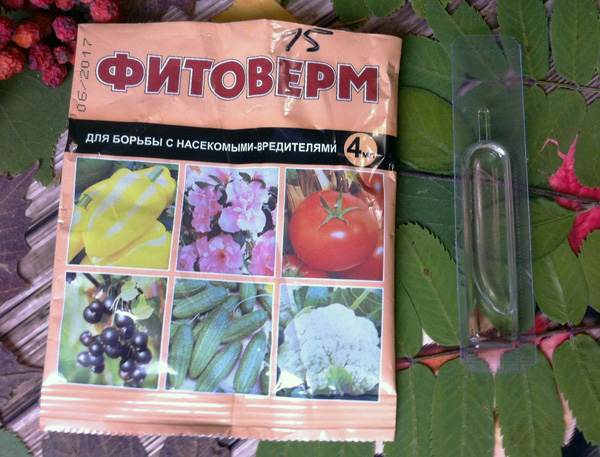
Fitoverm is one of the most popular acaricides in the fight against spider mites.
Due to the safety and lack of systemic action, Fitoverm can be used to treat trees and shrubs with already set fruits, as well as at home to protect flowers. Pests are likely to develop resistance to it and therefore it is usually used in early summer after FOS or pyrethroids have been applied prior to flowering.
Kleshchevit
Under the name Kleshchevit, a packaged version of Fitoverm is sold, which is convenient to poison the spider mite on home flowers, small flower beds and decorative free-standing shrubs, that is, where large amounts of working solution are not needed. Sold in 4 ml ampoules, one milliliter is enough to prepare 1 liter of working solution, the consumption rate of which is one liter per 1 meter of bush or tree height. About half a liter of solution is enough for a small juniper, and 3 liters will be required for an apple tree 2.5-3 meters high. Moreover, if there is no need to process a whole garden or vegetable garden, that is, a liter of highly concentrated Fitoverm is not required, it would be more rational to buy Kleshchevit.

The drug Kleshchevit is similar to Fitoverm.
neonicotinoids
To date, preparations based on neonicotinoids - Aktara, Konfidor, Zolotaya Iskra and others - are considered optimal for combating spider mites both in personal household plots and in large agricultural enterprises. They have several advantages over the means of other classes:
- Low toxicity to humans and warm-blooded animals;
- No danger to non-sucking and non-biting insects, including bees and predatory beetles - the active substance accumulates in plant tissues, but is absent on the surface of leaves and stems;
- The possibility of making funds through a drip irrigation system, without spraying the bushes;
- Low consumption rates due to the fact that plants absorb the drug from the soil.
In addition, it has been proven that neonicotinoids, when absorbed by the plant, accumulate in the leaves, but practically do not accumulate in the fruits, due to which they can be used even between flowering and harvesting.
On a note
Some drugs based on butoxycarboxym have a similar principle of action. For example, Plant-Pin sticks can be stuck one at a time into the ground of a pot with a plant and just water the flower as usual. The stick will dissolve in water, its substance will be absorbed from the soil by the plant, get into the juices and lead to tick poisoning. This is perhaps the most reliable and easiest way to get rid of spider mites at home. However, this agent is dangerous to bees and predatory arthropods and is therefore less desirable than neonicotinoids.
Neonicotinoids are the only drugs that can be used in the fight against spider mites in parallel with the use of predatory gamasid mites. Since the drug is located only in the vascular system of plants, it does not affect phytoseiulus in any way and they effectively destroy those individuals of tetranychids that survive on plants that, for one reason or another, did not absorb plant juices with poison.
Aktara
Aktara is both the name of the drug and a synonym for the name of the active substance - thiamethoxam.It is produced in the form of water-dispersible granules and in the form of a suspension concentrate, which dissolve in water and, depending on the situation, either spray the plants or water the ground under them with its working solution. The latter option is suitable for potted plants (ficuses, indoor citrus fruits - lemons, oranges, orchids) and for crops grown on drip irrigation.
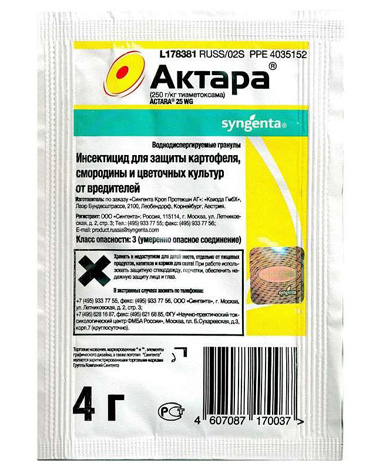
Aktara is the best remedy for treating domestic plants.
It is noteworthy that when applied to the soil, Aktara acts selectively on leaf-eating and sucking pests - spider mites, thrips, scale insects, aphids.
Considering the cost of the product - about 30 rubles per package of granules weighing 1.4 g - it can be considered the best remedy for home use, which allows you to remove spider mites without spraying plants and without risking the health of pets and people.
Hormonal preparations for the fight against spider mites
Preparations based on flufenzine and clofentezin are of particular interest due to the uniqueness of their action: instead of killing all active individuals (and with them many other arthropods, including very useful ones), they selectively sterilize female ticks and interrupt the development cycle of nymphs on those stages at which they enter the body of a particular individual. Due to the ability to penetrate into eggs, the agent stops embryonic development and prevents hatching of larvae from eggs.
At the same time, the means of this group - Apollo, Flumite - do not kill adult ticks and nymphs.Therefore, immediately after its application, it may seem that the remedy does not help: within 2-3 days, the number of ticks remains unchanged, and only with time does the death of adults become noticeable, which is not compensated by the maturation of nymphs and the appearance of new larvae from eggs.

Hormonal acaricide Apollo destroys parasites gradually.
The main advantage of hormonal drugs is their high safety. They do not affect insects and most mites, except for spider and flat mites, and therefore they can be used even during the flowering period of fruit trees without endangering pollinating insects.
On a note
Hormonal drugs are completely safe for humans. They do not affect the human hormonal background and do not cause disturbances in the production of certain hormones, since they act selectively only on the secretion glands in ticks.
Acaricides based on tetronic acids
These drugs, according to the principle of their action, are very similar to hormonal agents, but they do not affect the production of hormones, but the metabolism of specific lipids in the body of ticks. Such fat-like substances form the basis of cell membranes in the body of the pest itself and are part of the outer integument, protecting the arthropod from dehydration and the penetration of substances dangerous to the tick into the body. As soon as the acaricide blocks the production of these lipids, the development of almost all structures in the tick's body stops - the nymphs do not grow and develop the outer cover, the internal organs do not develop, the females do not develop eggs, and larvae do not develop in already laid eggs.The development of the entire population affected by the agent stops and the ticks begin to die from the inability to regenerate tissues. This decrease in numbers is not compensated by the appearance of new individuals, since females do not lay eggs, and larvae do not hatch from already laid eggs.
Judging by the reviews and the results of the experiments, a noticeable decrease in the number of mites when using acaricides based on tetronic acids occurs on the third or fourth day, and after a week or two, there are practically no mites on the plant.
The drugs in this group include Envidor (active ingredient - spirodiclofen), Oberon and Judo (spiromesifen). These are imported products, the same Envidor is produced by Bayer Corporation, and therefore you can buy them only at a relatively high price. For example, a 65 ml bottle of Envidor costs about 700 rubles, and a 2 ml bottle of JUDO costs about 500 rubles.
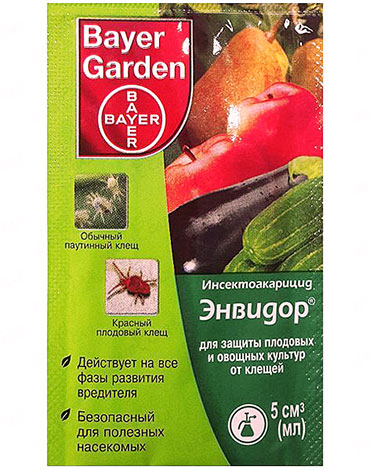
Since Envidor is a German-made drug, its cost is relatively high.
Carbamates and drugs based on them
According to the principle of action and safety profile, carbamates are close to pyrethroids and FOSs. They have a similar physiological effect, blocking acetylcholinesterase, quickly destroy mites, and with them aphids, whiteflies, thrips and many other arthropods, including useful ones. Many of them are relatively inexpensive and are often used as an alternative to pyrethroid-containing products for the treatment of seedlings, flowers and garden plants - cucumbers, peppers, tomatoes - before flowering and fruit set. They are toxic to humans and pets and require strict safety precautions for use.The main area of their application is the alternation with other insect-acaricides in the calendar schedule for processing plants in the garden or vegetable garden.
Complex preparations
To combat spider mites, drugs with a complex composition are rarely used. This is due to the fact that in the conditions of the garden and vegetable garden, plants are treated for ticks several times per season with alternating single-component agents, and even with pest resistance, one of them turns out to be effective. At home, it is relatively easy to carry out the treatment with a second drug if one turned out to be ineffective.
However, funds with a complex composition are available and, if desired, you can use them. They will kill the active stages of the mites the first time and only need to re-treat the plants to kill the larvae hatching from the eggs. These include, for example, Alatar (contains malathion and cypermethrin), Santomectin (active ingredients - ivermectin and closantel), Voliam Flexi (chlorantraniliprole and thiamethoxam), Organza (acetamiprid and lambda-cyhalothrin) and others.
According to experienced gardeners and flower growers, it is rational to use such complex remedies in the case when single-component preparations do not give a result.
Do folk remedies help with spider mites?
Folk remedies for spider mites are perhaps even more numerous than industrial ones. It’s easier to say than they don’t try to remove pests than to list those funds that people regularly use and which, judging by the reviews, give results. For example, we list the most famous:
- Ordinary laundry soap - it is dissolved in water, a thick soapy solution is made and the plant is sprayed with it, then washed off after 1-2 days to prevent the leaves from drying out. It is sometimes believed that an even more effective remedy is tar, sulfur-tar or green soap, but what the actual difference in their effectiveness is not known;
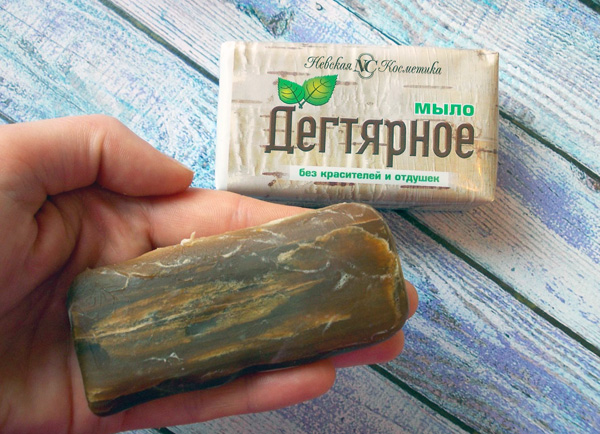
In some cases, the use of tar soap can help in the fight against spider mites.
- Onion infusion or decoction - only husks are usually used for its preparation, due to which the finished product acquires the color of strong tea;
- Ammonia (and similarly ammonia, although this is not the same thing), which destroys those ticks that it falls on. But you should not count on the deterrent effect of ammonia (as well as any other remedy) - even if the tick does not tolerate and is afraid of the smell of a particular drug, it will not physically be able to leave this or that bush and in any case will remain here and will multiply, unless he is killed. That is, it will not work to scare him away (including for prevention);
- Potassium permanganate - in its effectiveness is similar to soapy water, but much more difficult to acquire;
- Tooth powder - there are suggestions that, due to its high hygroscopicity, it leads to the death of mites from dehydration, in much the same way as means like Hector or Ecokiller do. However, the actual effectiveness of this remedy has not been tested and should not be considered a poison;
- Birch tar - it is used in much the same way as they poison lice. Theoretically, it should be effective, many reviews confirm this;
- Ash - it is crushed and simply sprinkled with an infected bush.The tool is doubtful, because in real conditions, during fires, mites would not survive on plants that got a lot of ash. But in reality it is not so;
- Hydrogen peroxide - kills ticks and their eggs even more effective than ammonia, but is also very dangerous for plants, leaving burns on them;

Hydrogen peroxide can do more harm than good, since its use is fraught with burns on the plant.
- Soda - two or three sprays are carried out with a solution at intervals of a week. As with ash, there are serious doubts about the effectiveness of such a remedy;
- Ammonia - in accordance with the popular recipe, it must be mixed with soda and poured with water in the ratio of 1 liter of water, 1 tbsp. spoon of soda, 1 tbsp. a spoonful of ammonia, mix everything and spray the plant with the resulting solution. Efficacy is not known, but there is a risk to plants;
- An ultraviolet lamp is clearly ineffective, since the dose of radiation that the lamp provides is definitely not enough to kill ticks. Moreover, pests are located on both sides of the leaves and it is almost impossible to illuminate them all;
- Copper sulfate is also an ineffective agent that is used as a fungicide and control of grape phylloxera, but it shows very weak activity against mites;
- A solution of toothpaste - it is not entirely clear why it is generally used against ticks, since there are no components toxic to ticks in such a solution. Nevertheless, the remedy is known and many use it, it is not known only with what effect;
- Coca-Cola - in terms of effectiveness, the remedy is similar to the previous one. There are no prerequisites for its effectiveness, but it is used and even positive reviews are written;
- Metronidazole - by itself, it is an antimicrobial agent, its effectiveness against tetranychids has not been tested, but there are reports that the use of its aqueous solution (one tablet per liter of water) can kill mites on flowers.
It is also sometimes believed that it is possible to fight spider mites by spraying plants with urea. In reality, this is not so. Urea allows you to treat diseased plants after a strong infection, as it stimulates tissue regeneration, but it has practically no effect on the mites themselves.
Be that as it may, all folk remedies allow you to destroy ticks only on individual plants and are mainly suitable for indoor flowers or for small flower beds. It is extremely difficult to use them for the treatment of horticultural and horticultural crops, trees simply because of the need to prepare large amounts of the drug.
Combining and alternating different means is the most effective approach
Almost always, for successful breeding, it is necessary to poison the spider mite two or more times with various means.
In the case of houseplants, the choice of means does not really matter - most of them are effective and, with two treatments, completely destroy ticks.
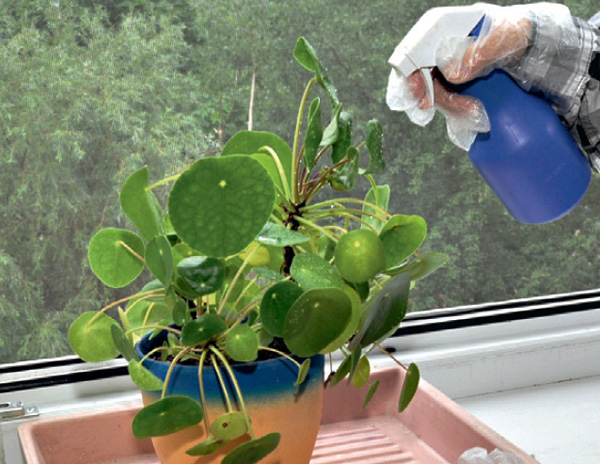
For indoor plants, often two treatments with any drug against spider mites will be enough to completely get rid of pests.
For processing in the garden and in the garden, it is important to choose such products that will not be stored and accumulated in the fruits.
As a rule, for the prevention of infection with ticks and their destruction, the following schemes are used:
- In the spring, before flowering, the plants are treated with FOS; in August, neonicotinoids are used for irrigation or for aerosol treatment;
- Before flowering, FOSs are used, in June-July - inhibitors of growth and development. If wintering females are noted on the trees by August, pyrethroid treatment is carried out after harvesting;
- Before flowering, pyrethroids or neonicotinoids are used (the latter are preferable), in summer - growth inhibitors.
As a private option, you can use drugs with a complex composition, but they do not allow you to limit yourself to only one treatment. Sometimes at home it is enough to treat plants with hormonal agents or protein synthesis inhibitors once, so that after a week or two there are no mites left.
Important rules for the use of insecticides at home and in the garden
Regardless of the type, most tick repellents are toxic to humans to some extent. This is especially true for organophosphorus compounds (especially when sprayed, in the fumigation phase) and pyrethroids (in high concentration they can cause severe poisoning in humans). Therefore, it is necessary to work with any means in strict accordance with the instructions for use and safety requirements. In particular, it is necessary to take into account the ability of a particular agent to accumulate in plant tissues and then remain in the harvested fruits.
When using any aerosol means, it must be remembered that the bulk of the mites are on the underside of the leaves, and therefore, in order to destroy them, it is necessary to spray them from the bottom up. Compressor sprayers are much more convenient for this than manual sprayers.
Finally, when fighting a tick in open ground conditions, additional agrotechnical measures should be taken: burn foliage from infected trees, dig in tree trunks, remove dense thickets of weeds (they are natural incubators of ticks and it is likely that the tick wound up in the garden from here), remove from the tree and burn the old dry bark in which the females hibernate in whole clusters. This will be a good prevention of the appearance of pests in the future and increase the likelihood that next year they will not have to fight again.
Video review of drugs against spider mites

